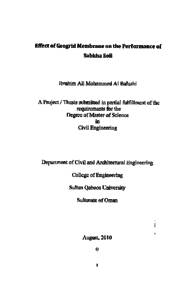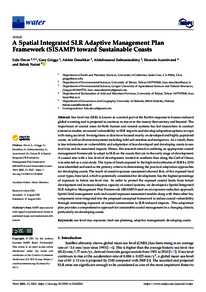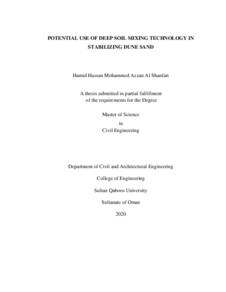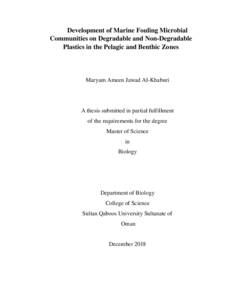Document
Effect of geogrid membrane on the performance of Sabkha soil
Publisher
Sultan Qaboos University
Gregorian
2010
Language
English
English abstract
During the last decades, the Arabian Gulf countries have gone through a spectacular phase of development. Inevitably, this resulted in utilization of virgin lands and large scale urbanization development programs. As Gulf countries have large coastal areas, the development programs included many construction sites in the coastal areas. During the geotechnical surveys which were created in these areas for investigation purposes by different researchers, some geotechnical problems were reported. One of the typical problems is the presence of the sabkha soil. The sabkha soils are problematic soils and they are characterized by the presence of salts. The type and amount of salt greatly affect the engineering properties of the soil. When the soil is dry, the salt is considered as a bonding agent that will increase the shear strength and reduce the compressibility of the soil. When the soil gets saturated, the salt dissolved resulting in a loose fabric soil causing an increase in the soil compressibility. This may lead the soil to collapse.
The purpose of this research was to investigate the load carrying capacity of sabkha soil using geogrid reinforcement and to investigate the effect of using geogrids on the performance of sabkha soil. The sabkha soil was collected from Al-Auzayba area, 2 km east of Muscat International Airport. The general geotechnical tests were conducted to investigate the engineering properties of the soil. Two testing models were used to carry out the loading tests.
The results obtained indicated that load carrying capacity of sabkha soil was very low especially when the soil was soaked. The use of geogrid in sabkha soil improved the load carrying capacity of sabkha. Sabkha- geogrid system can carry higher loads than the system without geogrids, particularly
in the soaked condition. The improvement on the load carrying capacity of soaked sabkha has a relation with numbers and spacing of the geogrid membranes. As the spacing decreases and the number of geogrid increases, the load carrying capacity of soaked sabkha increases. Also economical
analysis was conducted to compare the cost of geogrid as stabilization material with cost of cement stabilization system from which it was found that geogrid stabilization system is more economic than mixing sabkha with cement.
Description
Thesis
Member of
Resource URL
Arabic abstract
خلال العقود الماضية، شهدت دول الخليج العربي ولا زالت مرحلة مثيرة من التنمية والتطوير خاصة في مجال الإنشاءات. حيث أدى ذلك إلى إستغلال الأراضي المنتشرة في أنحائها و خاصة المناطق الساحلية لأغراض البناء و التعمير، ونظرا لوجود أنواع مختلفة من الأتربة في المنطقة و بخاصية النوعية الضعيفة منها كالسبخة ، فقد تم ملاحظة مشاكل عدة في مواقع البناء وخاصة بناء المنشأت والطرق من أبرزها هبوط الأرضيات و إنهيار بعض الطرق. تعتبر السبخة من أكثر أنواع التربة التي تسبب العديد من المشاكل في مجال الإنشاءات نظرا لطبيعة تكوين هذه التربة و التي تتميز بوجود كمية من الأملاح بها. حيث أن نوع وكمية الأملاح تؤثر تأثيرا كبيرا على الخصائص الهندسية التربة . فعندما تكون التربة جافة، فإن الأملاح تعتبر عامل الربط والتي تساهم في تعزيز قوة القص والحد من قابلية إنضغاط التربة، ولكن في حالة تشبع التربة بالمياه والرطوبة فإن الأملاح تذوب و يؤدي ذلك إلى سرعة إنضغاط التربة و إنهيارها في معظم الأحيان. يهدف هذا البحث دراسة إمكانية تحسين الحمولة الإستيعابية التربة السبخة بإستخدام نظام (الجيوجرد) والذي يعتبر أحد التقنيات الحديثة في رفع حمولة الأتربة وكذلك دراسة تأثير هذه التقنية على أداء تربة السبخة. بداية تم جمع كميات من تربة السبخة من منطقة العذيبة الواقعة بمسافة كيلومترين شرق مطار مسقط الدولي لإجراء الإختبارات الجيوتقنية العامة، لمعرفة الخصائص الهندسية للتربة وقد تم صنع قالبين مختلفي الحجم الإجراء الفحوصات المعملية لمعرفة سعة حمولة التربة. لقد أشارت النتائج المعملية أن تربة السبخة من أنواع الترب التي لها سعة حمولة منخفضة جدا في حالات التشبع بالمياه. وأن الحمولة الإستيعابية للسبخة إزدادت عند إستخدام مادة الجيوجرید. فعند زيادة عدد طبقات مادة الجيوجريد في العينات و تقليص المسافة بين هذه الطبقات، إزدادت الحمولة الاستيعابية للسبخة. كما تم مقارنة تكلفة مادة الجيوجريد في حالة إستخدامها كمادة مساعدة لزيادة الحمولة الإستيعابية للسبخة بمادة الإسمنت والتوصل إلى أن إستخدام الجيوجريد كمادة مساعدة أقل تكلفة من إستخدام الإسمنت كمادة مساعدة لزيادة الحمولة الإستيعابية للسبخة
Category
Theses and Dissertations




